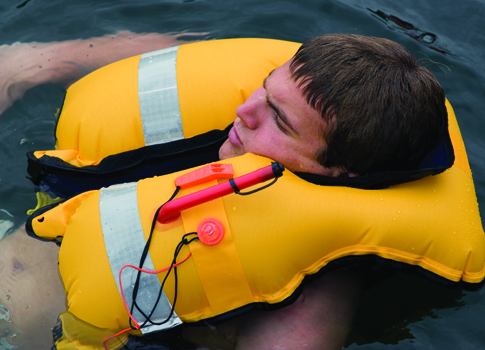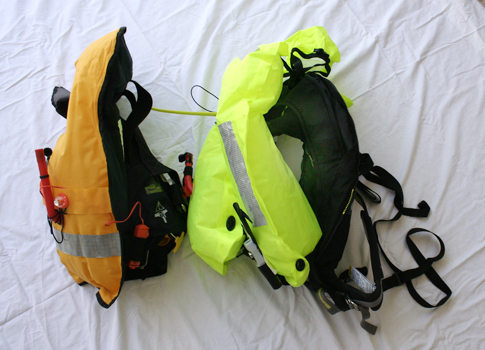
Within a day of US Sailing releasing a report that concluded that four out of five Spinlock Deckests failed to work properly in a fatal sailing accident earlier this year, PS testers were in the water with a Spinlock Deckvest (5D, 170N, Pro-Sensor inflator), trying to figure out what might have gone wrong. The new Deckvest was among several racing PFDs we looked at in the July 2013 issue, and at that time, we found no significant problems with it. It and the Deckvest Lite earned Recommended ratings. The accident report re-emphasizes what weve said several times before-inflate and try your PFDin the water as soon as you buy it. Make sure it keeps your head afloat without riding up around your head and neck. Learn how to service it, and adjust it for ideal fit. If it doesn’t fit, send it back and try another model.
I wont go into the details of the accident involving the Columbia 32C Uncontrollable Urge here. The full report covers that well-and I urge you to read it as well as the 2012 US Sailing accident reports. Ill focus only on inflatable bladder design detail that the investigators apparently blame for the vest’s failure. We have talked about this detail in the past, but in light of these findings, it bears repeating.
The main elements in the Spinlock Deckvest are the inflatable bladder and the neoprene harness/vest into which the bladder zips. On most inflatable PFD harnesses that we have tested, like those from Revere, Mustang, and West Marine, the bladder and the vest are integral components. The back of the bladder is sewn onto or thermo-welded to the vest. In some designs, however, like the Deckvest and the Bluestorm Xtreme, which we tested in August 2008, the bladders are joined to the vest at only three points-the top and the bottom of each side. An additional strap on the right side of the Deckvest holds the bladder close to the vest, but on the left side, there is none (see photo below). As a result, there can be a headsized gap between the vest and the bladder. If the vest is not cinched tightly, or if the inflatable PFD/harness does not have any crotch straps, the gap is even bigger, because the loose vest bunches up around the wearers neck and chest.

According to the accounts ofUncontrollable Urgecrewmemberswho had problems with their Deckvests, it appears that wave action (and/or body movement in the water as the wearers attempted to swim or were rolled in heavy surf) pushed the left side of the bladder up and over their heads. Craig Williams, the lone sailor who died, was found in the water unconscious with the bladder on one side of his head, according to the report. From the description of the other crew members who had problems with their vests, it seems that in heavy surf a persons head can squeeze through the gap between the vest and the bladder (or the entire left side of the vest slips over the head), and the PFD assumes this new lopsided position with the bladder on one side only.
Although we have not yet been unable to duplicate the scenario described in the accident report with our Deckvest, it could possibly occur if any of these conditions are present:
- Crotch straps are missing or loose. These straps need to be as snug as possible when working on the boat, and can be snugged up even more in the water. (Unfortunately, snug fit quickly becomes a problem because the straps become uncomfortable after a short period.)
- The vest is not tightened snugly against the body. Any vest should be fitted so that it can not ride up in the water. Have a partner try to lift you from the shoulder straps to check fit.
- The vest is not fully inflated. Partial inflation can be an advantage if you are trying to gain more mobility in the water, either when climbing into a lifeboat or struggling in surf, but doing this opens the gap between the bladder and the vest. In our view, a partially deflated vest should still maintain its form and close fit.
- Heavy breaking waves. Rough conditions can challenge any inflatable life jacket, even if it fits well and has a crotch strap.

It is possible that any of the inflatable harness/PFDs that we have tested could slip up or even completely off in the conditions encountered by the crew of Uncontrollable Urge. However, PFDs like the Deckvest and Bluestorm Xtreme that have the non-integral bladder seem to be more susceptible to fit issues in these conditions. This is another reason why we continue to prefer jackets with integral bladders like our Best Choice, the Mustang 3184, for offshore cruising, even though it is less compact. The Mustang 3184 is fitted with a hydrostatic Hammar inflator, which is more resistant to accidental inflation than other inflators, but it is more difficult to service. On the plus side, the interval between servicing is longer. Any of the other harness/PFDs that have earned Recommended ratings in the August 2008 or December 2006issues would do as well.
The Spinlock Vests are the only vest with a non-integral bladder that we have given Recommended rating, and the basis of the recommendation rested greatly on the vest’s compact fit when not inflated, and its easy-to-service Pro Sensor inflation system that resists accidental inflation.
In an e-mail to PS, James Hall of Spinlock pointed out that the conditions the accident were extremely demanding for any vest. He said the company was in close contact with panel members who wrote the report and reviewing responses to the report to see if changes can be made to future product range.
“The bladder attachment of our lifejacket is not fundamentally different to the majority of inflatable lifejackets available,” he said. “All lifejackets already go through a number of rigorous approval tests that include a 10-feet jump test with an inflated bladder to ensures the lifejacket stays in position. Given the unique circumstances of the incident, manufacturers and the lifejacket approval bodies – ISO 12402 committee and the USCG must take the opportunity to review the performance testing requirements for lifejackets.
“In our own testing we found that the correct, secure fitting of the chest belt and leg or crutch straps have the largest impact on the performance of all lifejackets.”
It is possible that regulatory agencies like the U.S. Coast Guard may review the reports findings and ammend their testing protocols, but this is usually a lengthy process. Here at Practical Sailor we have already begun discussing including a “surf test” in future inflatable PFD tests. In the meantime, we urge readers to be conscious of PFD fit inflated and in the water, as well as be familiar with servicing regimen. If your current vest does not have a crotch strap, consider adding one, or at least follow our recommendation that the vest be snugy fitted around the torso.
Links to servicing popular types of inflation systems can be found at the bottom of the online version of theJuly 2013 editorial.
Here at Practical Sailor, were continuing work on our own improved PFD/harness design. Weve gotten some great ideas from some of our engineers in the audience as well as from some well-respected racers and offshore sailors. My March 13, 2012 blog post and March 2012 editorial describe what were doing and how you can help. One product that recently caught our eye was the new Quatic Big Wave Surf. The vest, which we have not yet tested, seems to offer a better balance of flotation and mobility that many of our reader-submitted designs sought to achieve. It seems to be particularly well-suited for situations like this and two other recent sailing accidents in California-one in the Farallones Islands near San Francisco and one in a race out of Ensenada-when sailboats were driven toward rocky shores and surf.

































